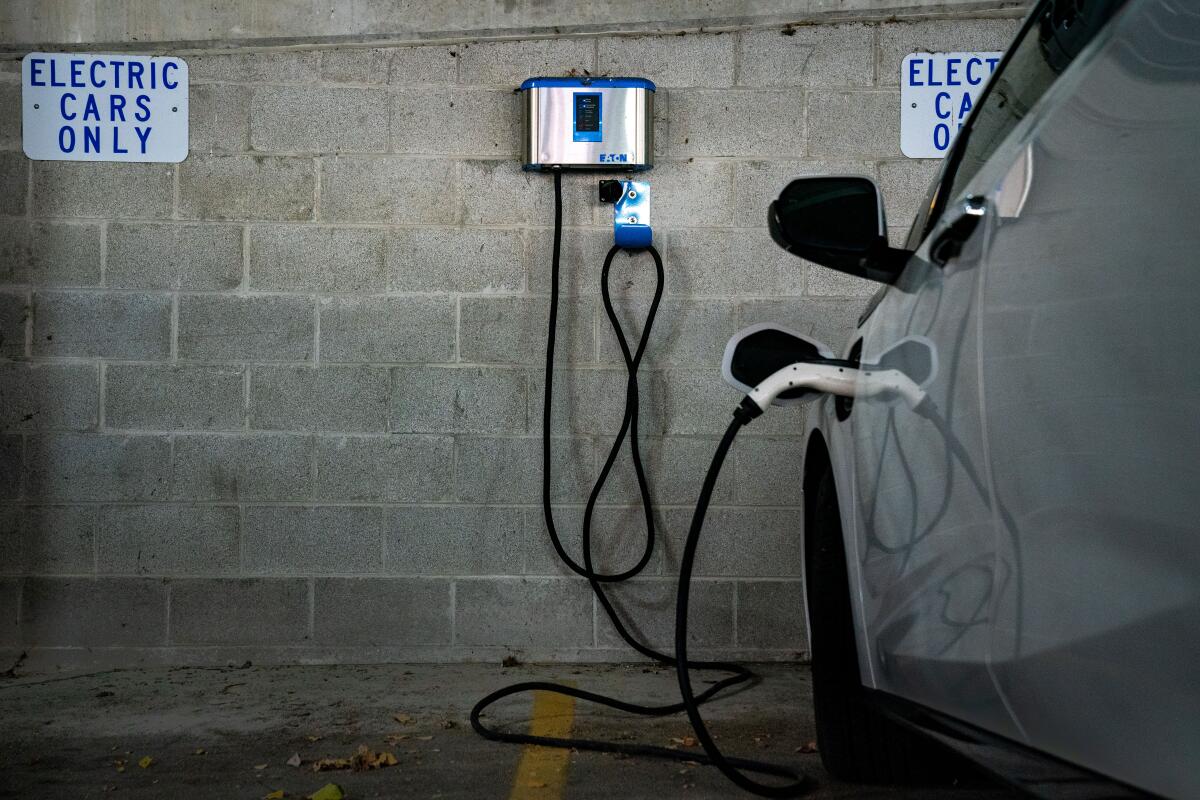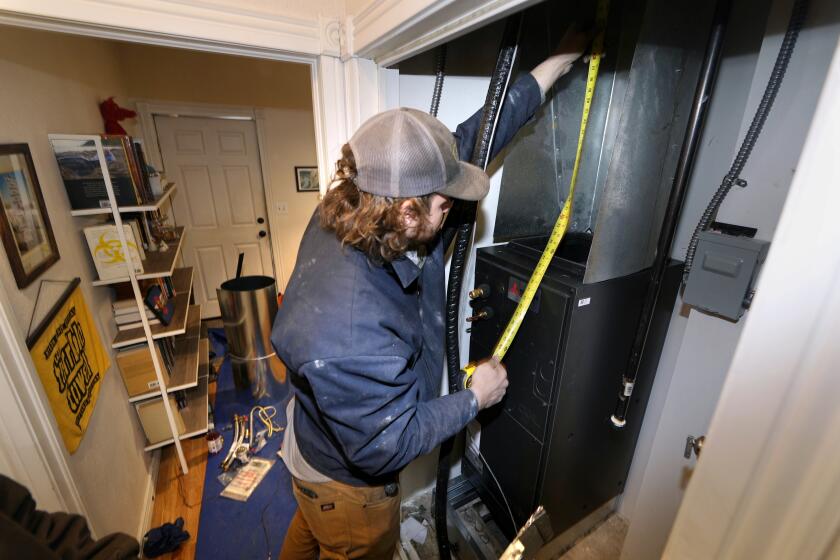Editorial: California should tap its growing fleet of EVs to prevent blackouts

- Share via
Between ferocious heat that pushed California’s electrical grid to the brink and winter storms that knocked out power to hundreds of thousands of people, it has become increasingly clear we need backup sources of power to keep the lights on.
For California to achieve its climate goals and get 100% of its electricity from zero-carbon sources by 2045, the state also needs to add huge amounts of battery storage to capture renewable energy when it’s plentiful and release it into the electrical grid when demand surges on hot summer evenings after the sun goes down.
There’s an existing and growing fleet of battery storage that’s virtually untapped so far: the roughly 1 million electric vehicles already on the road in California. When plugged in at homes, offices and charging stations, and with the right equipment, many could become mini power plants, available to quickly feed the electricity stored in their batteries to the grid when demand peaks and it’s needed most to prevent blackouts, and also power homes when utilities shut off electricity to prevent wildfires. That could be incredibly helpful as California confronts extreme weather and increased power demand from the electrification of our economy.
Yet even as plug-in vehicles account for nearly 1 in 5 new car sales in California, efforts to use them to buoy the grid are still in their infancy. There have been a few demonstration programs, but vehicle-to-grid, as it is known, remains largely unused.
Nearly 1 in 5 new car sales in California were zero-emission in 2022, but most of them are Teslas and other high-end models. That shows how far the state has to go in making the shift to electric vehicles equitable.
State policymakers haven’t done enough to encourage vehicle-to-grid in tandem with the adoption of electric cars. That’s unfortunate, because it just makes sense to give a second job to the electric vehicles that Californians are going to be buying in increasing numbers as the state begins to phase out new sales of gas-powered cars in the coming years.
All those electric car batteries add up to a lot of unrealized potential. State officials are anticipating a more than sixfold increase in electric vehicles by 2030, and if only 1 in 10 of those vehicles were plugged in and able to provide electricity to the grid, they would add up to 6,000 megawatts of backup power for several hours to help avoid blackouts, according to the California Energy Commission. That’s the equivalent of having more than two additional Diablo Canyon nuclear power plants.
The obstacles are not so much technological as logistical and financial. Cars and charging stations need to be equipped with the ability to send electricity in both directions, and with communications systems to measure the flow of power. Currently it costs thousands of dollars to outfit a home for vehicle-to-grid.
State regulators have already adopted rules allowing vehicles to connect to the grid but should be doing more to make it a widespread reality. This is a promising source of clean, reliable power that California needs to prioritize by adopting rules and standards for cars and chargers and well-crafted incentives for vehicle owners. It could provide a pollution-free alternative to firing up fossil-fueled gas plants and generators to prevent blackouts during heat waves, which would be a win for public health and the planet.
Bay Area regulators’ plan to adopt the nation’s first rules phasing out sales of gas-fueled water heaters and furnaces in favor of zero-emission electric heat pump models should be replicated across the state and nation.
California has an incentive program that could be retooled to outfit EV batteries as backup power stations. When the state slashed its rooftop solar subsidy program in December, it added new provisions to incentivize property owners to install stationary battery systems to store excess energy for use after the sun goes down.
“Why would we make a second investment in more batteries? Why wouldn’t we focus on trying to utilize those batteries that these households already have?” state Sen. Nancy Skinner (D-Berkeley) said at a Feb. 28 committee hearing. “It is a rare household that uses their car more than a few hours a day . . . so this capacity of that battery is just sitting there unused.”
It will take an act of Congress to make daylight saving time permanent. Fortunately the Senate has already voted unanimously to adopt it. Now, it’s time for the House to do the same.
To that end, Skinner introduced a bill earlier this year that sets a goal to require all new zero-emission cars and charging equipment to include technology to enable vehicle-to-grid by 2027, an important first step.
There are other ways of taking advantage of vehicle batteries short of sending their power onto the grid. Time-of-use rates already push users to avoid charging during peak hours in the late afternoon and early evening. More electric vehicles are being built with the capability of sending electricity in both directions, which on the Ford F-150 Lightning can power a home for three days, though it’s still limited to a handful of models.
But EVs can do much more. California needs policies now to enable the batteries of all the new electric cars that will soon be parked in driveways and garages to help make the transition to carbon-free electricity as smooth as possible.
More to Read
A cure for the common opinion
Get thought-provoking perspectives with our weekly newsletter.
You may occasionally receive promotional content from the Los Angeles Times.













